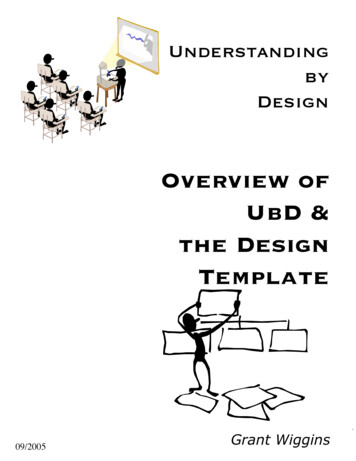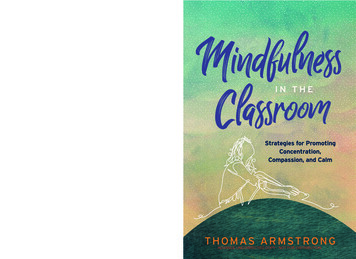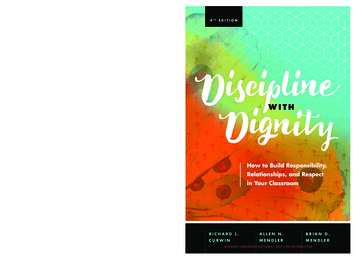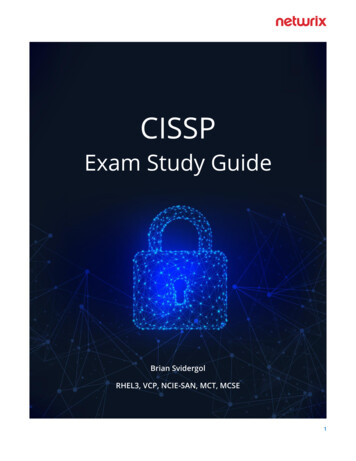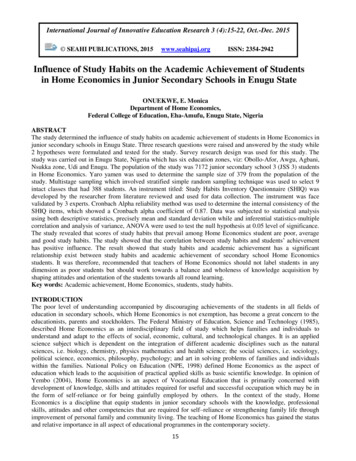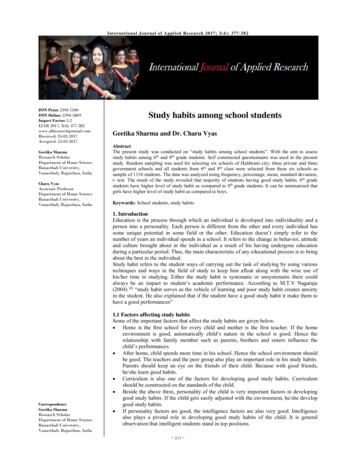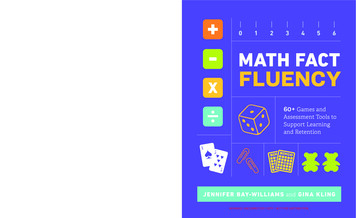
Transcription
E D U C AT I O NXIn Math Fact Fluency, experts Jennifer Bay-Williams and Gina Klingprovide the answers to these questions—and so much more. This bookoffers everything a teacher needs to teach, assess, and communicatewith parents about basic math fact instruction, including The five fundamentals of fact fluency, which provide a researchbased framework for effective instruction in the basic facts. Strategies students can use to find facts that are not yetcommitted to memory. More than 40 easy-to-make, easy-to-use games that provideengaging fact practice. More than 20 assessment tools that provide useful data on factfluency and mastery. Suggestions and strategies for collaborating with families to helptheir children master the basic math facts.BAY-W IL L IAM S and KL IN G-MATH FACT FLUENCY Mastering the basic facts for addition, subtraction, multiplication, and division is an essential goal for all students.Most educators also agree that success at higher levels ofmath hinges on this fundamental skill. But what’s the bestway to get there? Are flash cards, drills, and timed teststhe answer? If so, then why do students go into the upperelementary grades (and beyond) still counting on theirfingers or experiencing math anxiety? What does researchsay about teaching basic math facts so they will stick? 0123456- MATH FACTFLUENCYX60 Games andAssessment Tools toSupport Learningand RetentionMath Fact Fluency is an indispensable guide for any educator who needsto teach basic facts. This approach to facts instruction, grounded in yearsof research, will transform students’ learning of basic facts and help thembecome more confident, adept, and successful at math.STUDYGUIDEONLINEBrowse excerpts from ASCDbooks: www.ascd.org/booksJ EN N IF ER BAY-WILLIA MS and G IN A K LI N GAlexandria, VA USAReston, VA USAADVANCE UNCORRECTED COPY - NOT FOR DISTRIBUTION
1703 N. Beauregard St. Alexandria, VA 22311-1714 USAPhone: 800-933-2723 or 703-578-9600 Fax: 703-575-5400Website: www.ascd.org E-mail: member@ascd.orgAuthor guidelines: www.ascd.org/write1906 Association Drive,Reston, VA 20191-1502Phone: 800-235-7566Website: www.nctm.orgE-mail: publications@nctm.orgDeborah S. Delisle, Executive Director; Stefani Roth, Publisher; Genny Ostertag, Director, Content Acquisitions; Allison Scott, Acquisitions Editor; Julie Houtz, Director, Book Editing & Production; Liz Wegner, Editor; Judi Connelly, Associate Art Director; Masie Chong, Graphic Designer;Valerie Younkin, Production Designer; Mike Kalyan, Director, Production Services; Shajuan Martin, E-Publishing Specialist; Kelly Marshall, Senior Production SpecialistPublished simultaneously by ASCD and the National Council of Teachers of Mathematics.Copyright 2019 ASCD. All rights reserved. It is illegal to reproduce copies of this work in print orelectronic format (including reproductions displayed on a secure intranet or stored in a retrievalsystem or other electronic storage device from which copies can be made or displayed) withoutthe prior written permission of the publisher. By purchasing only authorized electronic or printeditions and not participating in or encouraging piracy of copyrighted materials, you supportthe rights of authors and publishers. Readers who wish to reproduce or republish excerpts ofthis work in print or electronic format may do so for a small fee by contacting the CopyrightClearance Center (CCC), 222 Rosewood Dr., Danvers, MA 01923, USA (phone: 978-750-8400; fax:978-646-8600; web: www.copyright.com). To inquire about site licensing options or any otherreuse, contact ASCD Permissions at www.ascd.org/permissions, or permissions@ascd.org, or703-575-5749. For a list of vendors authorized to license ASCD e-books to institutions, see www.ascd.org/epubs. Send translation inquiries to translations@ascd.org.ASCD and ASCD LEARN. TEACH. LEAD. are registered trademarks of ASCD. All other trademarks contained in this book are the property of, and reserved by, their respective owners, andare used for editorial and informational purposes only. No such use should be construed toimply sponsorship or endorsement of the book by the respective owners.Excerpts from Common Core State Standards Copyright 2010. National Governors Association Center for Best Practices and Council of Chief State School Officers. All rights reserved.All web links in this book are correct as of the publication date below but may have become inactive or otherwise modified since that time. If you notice a deactivated or changed link, pleasee-mail books@ascd.org with the words “Link Update” in the subject line. In your message, pleasespecify the web link, the book title, and the page number on which the link appears.PAPERBACK ISBN: 978-1-4166-2699-2 ASCD product #118014 n1/19PDF E-BOOK ISBN: 978-1-4166-2722-7NCTM Stock #15799Quantity discounts are available: e-mail programteam@ascd.org or call 800-933-2723, ext. 5773, or703-575-5773. For desk copies, go to www.ascd.org/deskcopy.Library of Congress Cataloging-in-Publication DataNames: Bay-Williams, Jennifer M., author. Kling, Gina, author.Title: Math fact fluency : 60 games and assessment tools to support learning and retention /Jennifer Bay-Williams, Gina Kling.Description: Alexandria, VA : ASCD, [2019] Includes bibliographical references and index.Identifiers: LCCN 2018033940 (print) LCCN 2018038568 (ebook) ISBN 9781416627227 (PDF) ISBN 9781416626992 (pbk.)Subjects: LCSH: Mathematics--Study and teaching (Elementary) Games in mathematicseducation.Classification: LCC QA135.6 (ebook) LCC QA135.6 .B39425 2019 (print) DDC372.7/044--dc23LC record available at https://lccn.loc.gov/201803394028 27 26 25 24 23 22 21 20 191 2 3 4 5 6 7 8 9 10 11 12ADVANCE UNCORRECTED COPY - NOT FOR DISTRIBUTION
MATH FACTFLUENCYPreface . . . . . . . . . . . . . . . . . . . . . . . . . . . . . . . . . . . . . . . . . . . . . . . . . . . . . . . . . . . . . . . . . . . . . . . . . . . . . . vii1. The Five Fundamentals . . . . . . . . . . . . . . . . . . . . . . . . . . . . . . . . . . . . . . . . . . . . . . . . . . . . . . . . . . . . . . 12. Foundational Addition and Subtraction Facts . . . . . . . . . . . . . . . . . . . . . . . . . . . . . . . . . . . . . 133. Derived Fact Strategies for Addition and Subtraction . . . . . . . . . . . . . . . . . . . . . . . . . . . . .344. Foundational Multiplication and Division Facts . . . . . . . . . . . . . . . . . . . . . . . . . . . . . . . . . . .625. Derived Fact Strategies for Multiplication and Division . . . . . . . . . . . . . . . . . . . . . . . . . . .836. Assessing Foundational Facts . . . . . . . . . . . . . . . . . . . . . . . . . . . . . . . . . . . . . . . . . . . . . . . . . . . . .1067. Assessing Derived Fact Strategies and All Facts . . . . . . . . . . . . . . . . . . . . . . . . . . . . . . . . . . . 1288. Families and Facts . . . . . . . . . . . . . . . . . . . . . . . . . . . . . . . . . . . . . . . . . . . . . . . . . . . . . . . . . . . . . . . . .158References . . . . . . . . . . . . . . . . . . . . . . . . . . . . . . . . . . . . . . . . . . . . . . . . . . . . . . . . . . . . . . . . . . . . . . . . . . . 173Index . . . . . . . . . . . . . . . . . . . . . . . . . . . . . . . . . . . . . . . . . . . . . . . . . . . . . . . . . . . . . . . . . . . . . . . . . . . . . . . . 178About the Authors . . . . . . . . . . . . . . . . . . . . . . . . . . . . . . . . . . . . . . . . . . . . . . . . . . . . . . . . . . . . . . . . . .186ADVANCE UNCORRECTED COPY - NOT FOR DISTRIBUTION
PrefaceBasic facts truly are the foundation on which all mathematical computation is based(larger numbers, rational numbers, operations with variables, and so on). However,too many students leave elementary school lacking fluency with the basic facts.Clearly, the historical (and still prominent) approach to teaching basic facts has beenineffective. This is because there are two fundamental flaws in this type of instruction: (1) a lack of attention to strategies, falsely assuming students can go straightfrom counting (or skip counting) to just knowing the facts; and (2) a lack of effectiveassessment, falsely assuming that timed tests can provide meaningful data on student mastery of basic facts. Despite the ineffective and potentially damaging effect ofthese teaching and assessment approaches, basic fact instruction has changed verylittle over the years. It is time for a change!This book is structured around five fundamentals for transforming basic factinstruction. These fundamentals are firmly grounded in research and collectivelyoutline a plan for students that results in lasting learning of the facts, without damaging side effects. By exploring the meaning of numbers and operations, describingtheir thinking, making sense of the strategies of their peers, and engaging in meaningful practice, students eventually reach mastery of the basic facts, all the whilebecoming empowered to think and act like mathematicians. Chapter 1 provides abrief, clear description of the five fundamentals. Chapters 2 and 3 describe the learning progressions for addition and subtraction facts, including a plethora of strategies,activities, and games, while Chapters 4 and 5 do the same for multiplication and division. The 40 games in this book (listed at the end of this preface) are fun, but that isnot why we included them. Games provide the opportunity to talk about strategies,practice a newly learned strategy, and become more efficient at using strategies untilviiADVANCE UNCORRECTED COPY - NOT FOR DISTRIBUTION
viiiMath Fact Fluencyautomaticity with the basic facts has been attained. Did you notice how many timesthe word strategy was used in the last sentence? It is that important! This word isoften used in many different ways in the classroom, but in this book we only use thisterm to refer to thinking strategies. As you will learn, these thinking strategies are thekey to helping students developing lasting fact mastery.The activities and games featured in this book also serve a secondary purpose:assessment. While students are busy playing games and talking about their thinking,you have an opportunity to employ assessment techniques that will provide far better data than a timed quiz, all the while avoiding the negative impacts of such assessments. Chapters 6 and 7 provide ideas for observation tools, easy interviews, formalinterviews, journal prompts, and ways to monitor student progress toward masteryof the foundational fact sets (Chapter 6) and derived fact sets (Chapter 7).One particular challenge with the basic facts is understanding the myriad ofterms: fluency, automaticity, rote memorization, knowing from memory, mental strategies, and mastery. In this book, we focus on the accepted, research-based definitionof fluency, which delineates four components: “skill in carrying out procedures flexibly, accurately, efficiently, and appropriately” (National Research Council, 2001, p. 116).This definition expands the focus of mastering facts to include strategies and flexibility, as compared to a focus solely on accuracy and efficiency. Many people, including parents, principals, teachers, politicians, and students, think of fluency as simplybeing able to say a fact quickly (automaticity). Educating everyone about this morecomprehensive notion of fluency is absolutely essential to helping every child learnbasic math facts for life and feel confident and competent about their ability to domath. Chapter 8 focuses on ways to engage families and other stakeholders in understanding the importance of fluency, as well as how they can help their own childrenbecome fluent with the basic facts.Our own advocacy for change, through countless presentations and several journal articles, has resulted in many schools adopting different approaches to teachingbasic facts, implementing ideas that are now in this book. These instructional programs and assessment tools have resulted in dramatic change in some schools: morestudents achieving mastery through games and other activities (as opposed to drillor rote memorization), students becoming more excited about mathematics and confident in their abilities, and teachers feeling that they are doing a better job at preparing their students with the basics. For example, a 2nd grade teacher recently emailedJennifer this message at the end of the year: “I was a very math-averse teacher whohad no idea how to teach students concretely about math. That changed this yearADVANCE UNCORRECTED COPY - NOT FOR DISTRIBUTION
Prefacewith our focus on explaining reasoning strategies and showing their thinking usinga variety of visual models. One of the best compliments I got from a student thisyear was ‘I love math.’” Teachers at these sites have often asked us, “Will you writea book?” As we pondered undertaking such a task for several years, we realized thata worthwhile book must not only provide explanations but must also be burstingwith activities, games, and tools that could be lifted right out of the book and putto use. That is what we have written. We recognize we are asking for fundamentalchanges to teaching basic facts. We encourage you to reflect on the way in which ourfive fundamentals align with your school’s basic fact plan and consider how a shifttoward incorporating these ideas could affect the learning and experiences of yourstudents. As you identify a focus and a plan, we hope this book will provide you withthe activities, games, and tools to support your own basic fact teaching and assessment transformation.FIGURE P.1 Games in This BookGameChapterTargeted FactsGame 1: Sleeping Bears2Sums within 5Game 2: Bears Race to 102 0, 1, 2Game 3: Bears Race to 02–0, 1, 2Game 4: Bears Race to Escape2 /– 0, 1, 2Game 5: Doubles Match-Up2Doubles (sums)Game 6: Doubles Bingo2Doubles (sums)Game 7: 10 Sleeping Bears2Combinations of 10Game 8: Go Fish for 10s2Combinations of 10Game 9: Erase2Combinations of 10ADVANCE UNCORRECTED COPY - NOT FOR DISTRIBUTIONix
xMath Fact FluencyFIGURE P.1 Games in This Book—(continued)GameChapterTargeted FactsGame 10: Square Deal210 factsGame 11: Lucky 133Sums within 20 (and differencesfrom 13)Game 12: Sum War3Sums within 20Game 13: Bingo3Sums within 20Game 14: Concentration3Sums within 20Game 15: Dominoes3Sums within 20Game 16: Four in a Row3Sums within 20Game 17: Old Mascot (Old Maid)3Sums within 20Game 18: Diffy Dozen3Differences within 12(comparison)Game 19: Salute3Sums and differences within 20Game 20: Target Difference3Differences within 20Game 21: Subtraction Stacks3Differences of 5 or lessGame 22: Around the House3Sums and differences that equal10 or lessGame 23: Dirty Dozen3Sums and differences within 12Game 24: First to 203Sums and differences within 20Game 25: Sticker Book Patterns4Comparing multiplication representations (groups and arrays)ADVANCE UNCORRECTED COPY - NOT FOR DISTRIBUTION
PrefaceGameChapterTargeted FactsGame 26: On the Double42s (doubles) factsGame 27: Trios45s factsGame 28: Capture 5 First42s, 5s, 10s factsGame 29: How Low Can You Go?40s, 1s factsGame 30: Squares Bingo4SquaresGame 31: MultiplicationPathways4Foundational multiplicationfactsGame 32: Fixed Factor War5DoublingGame 33: Strive to Derive5Adding/subtracting a groupGame 34: Crossed Wires5Break apartGame 35: Rectangle Fit5Break apart, commutativityGame 36: The Factor Game5Division (finding factors)Game 37: The Right Price5Close-by division factsGame 38: Multiplication Salute5Multiplication and division factsGame 39: The Product Game5Multiplication and division factsGame 40: Net Zero5All four operationsGame 41: Softball Hits5All four operationsGame 42: Three Dice Take5All four operationsADVANCE UNCORRECTED COPY - NOT FOR DISTRIBUTIONxi
xiiMath Fact FluencyFIGURE P.2 Assessment Tools in This BookTitleChapterTool 1: Observation Tools for Foundational Fact Sets6Tool 2: Observation Tool for /– 0, 1, 26Tool 3: Observation Tool for 2s, 10s, and 5s6Tool 4: Observation Tools for Combinations of 10 and Doubles6Tool 5: Observation Tool for 5s Facts6Tool 6: Two-Prompt Interview Protocol6Tool 7: Interview Record for Combinations of 106Tool 8: Interview Record for Multiplication Squares6Tool 9: Mastery of Foundational Facts Records6Tool 10: Rubrics for Foundational Fact Fluency6Tool 11: Journal Writing Prompts for Doubles6Tool 12: Foundational Facts Progress Chart for Multiplication6Tool 13: Observation Tool for the Making 10 Strategy7Tool 14: Observation Tool for Any Multiplication Derived FactStrategy7Tool 15: Observation Tools for Selection of Strategies7Tool 16: Observation Tool for Strategies and Mastery for AdditionFacts7ADVANCE UNCORRECTED COPY - NOT FOR DISTRIBUTION
PrefaceTitleChapterTool 17: Observation Tool for Strategies and Mastery forMultiplication Facts7Tool 18: Interview Prompts for Assessing Fluency During Game Play7Tool 19: Four Facts Protocol Follow-Up Interview Questions7Tool 20: Student Records for Addition7Tool 21: Student Records for Multiplication7Tool 22: Exit Interview for Addition Facts7Tool 23: Holistic Rubric for Basic Fact Fluency7Tool 24: A Dozen Writing Prompts for Basic Fact Fluency7Tool 25: Progress Monitoring Tool for Addition Facts7Tool 26: Progress Monitoring Tool for Multiplication Facts7Most, if not all, of the 42 games and 26 assessment tools can be readily adaptedto other fact sets and operations (e.g., addition games can be turned from sums intoproducts). So, there are truly more than 100 possible games and tools for you—enoughto ensure your students are able to truly develop math fact fluency!ADVANCE UNCORRECTED COPY - NOT FOR DISTRIBUTIONxiii
1The Five FundamentalsYou’ve probably heard it a thousand times: Kids need to be fluent with basic mathfacts. You’ve probably seen the word fluency on progress reports, in elementary mathematics standards, and in textbooks, but what does fluency actually mean? For nearlya decade, we’ve been asking this question to teachers and administrators. Commonresponses include “They just know the facts.” “They are fast and accurate.” “They understand what the fact means.” “They have strategies to figure out the facts.” “It’s like when you are fluent in a language—you don’t have to think or hesitate much.” “They are automatic with the facts.” “They can apply their understanding of the facts to new situations.”As you can see, the school community has struggled to embrace a common andcomprehensive definition of fluency. Some definitions focus on speed, while othersfocus on understanding. Reaching the goal of basic fact fluency requires establishinga shared and complete understanding of the term. As baseball great Yogi Berra oncenoted, “If you don’t know where you’re going, you’ll end up someplace else.” This is thetenet behind the first of our five basic fact fundamentals; the four that follow lay out1ADVANCE UNCORRECTED COPY - NOT FOR DISTRIBUTION
2Math Fact Fluencyessential elements for designing an effective plan—one that will help every studentlearn (and remember) the basic facts while building mathematical confidence andnumber sense.Fundamental 1: Mastery Must Focus on FluencyProcedural fluency includes accuracy, efficiency, flexibility, and appropriate strategyselection (National Research Council, 2001). Note that this definition of proceduralfluency applies to all operations, not just basic facts, and these elements of fluencyare interrelated (Bay-Williams & Stokes Levine, 2017) as illustrated by the diagram inFigure 1.1.FIGURE 1.1 What Procedural Fluency Is and What It Looks LikeComputingwith . . .What It Looks LikeAccuracyCorrect answerEfficiencyTime needed to solve is reasonable.Selected strategy “fits” the numbersin the problem (i.e., AppropriateStrategy Selection).ProceduralFluencyFlexibilityStrategy is applied to new problems.Strategy is adapted to betterfit the problem.The four components (bolded) are interrelated. Appropriate strategy selection isrequired for efficiency and flexibility.Applying strategies is different than applying algorithms. According to theCouncil of Chief State School Officers (CCSSO) and National Governors Association(NGA), computation strategies are “purposeful manipulations that may be chosen forspecific problems,” while algorithms are a “set of predefined steps applicable to a classADVANCE UNCORRECTED COPY - NOT FOR DISTRIBUTION
The Five Fundamentalsof problems” (CCSSO & NGA, 2010, p. 85). When students only learn a single procedure,regardless of how quickly and accurately they can implement it, they are denied theopportunity to develop procedural fluency. Strategy selection, adaptation, and transference are critical to both procedural fluency and mathematical proficiency andmust be a significant part of students’ experiences with the operations right from thebeginning, with learning basic facts.We use these general definitions of each component to focus specifically on basicfact fluency: Accuracy: the ability to produce mathematically precise answers Efficiency: the ability to produce answers relatively quickly and easily Appropriate strategy use: the ability to select and apply a strategy that isappropriate for solving the given problem efficiently Flexibility: the ability to think about a problem in more than one way and toadapt or adjust thinking if necessaryConsider these aspects of fluency in terms of level of cognition. Which of theserequires higher-level thinking? Selecting a strategy, key to both efficiency and flexibility, requires first understanding how and when each strategy is appropriate, andthen analyzing a problem to select a viable strategy. Notice that fluency requiresunderstanding, applying, analyzing, and comparing—all higher-level thinking processes. The more students are asked to think at a higher level, the more they learn.Basic facts are also described in terms of fluency in state and national standards,such as in these examples from the Common Core State Standards (CCSSO & NGA,2010) (emphasis added):1.OA.6 (Grade 1): Add and subtract within 20, demonstrating fluency for addition and subtraction within 10. Use strategies such as counting on; makingten (e.g., 8 6 8 2 4 10 4 14); decomposing a number leading to a ten(e.g., 13 – 4 13 – 3 – 1 10 – 1 9); using the relationship between additionand subtraction (e.g., knowing that 8 4 12, one knows 12 – 8 4); and creating equivalent but easier or known sums (e.g., adding 6 7 by creating theknown equivalent 6 6 1 12 1 13). (p. 15)2.OA.2 (Grade 2): Fluently add and subtract within 20 using mental strategies [with a reference to 1.0A.C.6]. By end of Grade 2, know from memory allsums of two one-digit numbers. (p. 19)3.OA.7 (Grade 3): Fluently multiply and divide within 100, using strategiessuch as the relationship between multiplication and division (e.g., knowingADVANCE UNCORRECTED COPY - NOT FOR DISTRIBUTION3
4Math Fact Fluencythat 8 5 40, one knows 40 5 8) or properties of operations. By the endof Grade 3, know from memory all products of two one-digit numbers. (p. 23)These standards acknowledge that it is through the application of strategies thata student develops fluency, and it is through the use of strategies that students cometo know their basic facts, or develop automaticity (more on this point in the next section). However, the activities and assessments traditionally associated with learningbasic facts (such as drill, flash cards, and timed testing) exclusively focus on students’accuracy and one part of efficiency (speed), neglecting strategy development. Manystudies over many years have compared traditional basic fact instruction (i.e., drill)to strategy-focused instruction. All of them show that strategy groups outperformtheir peers on using strategies and on automaticity and accuracy (Baroody, Purpura,Eiland, Reid, & Paliwal, 2016; Brendefur, Strother, Thiede, & Appleton, 2015; Locuniak& Jordan, 2008; Purpura, Baroody, Eiland, & Reid, 2016; Thornton, 1978, 1990; Tournaki,2003). We know that strategy development is absolutely necessary for fluency. Andfluency is essential to developing automaticity with basic facts.Fundamental 2:Fluency Develops in Three PhasesAs students come to know basic facts in any operation, they progress through threephases (Baroody, 2006): Phase 1: Counting (counts with objects or mentally) Phase 2: Deriving (uses reasoning strategies based on known facts) Phase 3: Mastery (efficiently produces answers)Consider these phases in the context of mastering addition facts. Most studentsenter kindergarten or 1st grade using counting to solve addition or subtraction problems. They may be counting with objects, on their fingers, or in their heads, but,regardless, these students are still considered to be at Phase 1. As they start to learnsome of the easier facts (usually 2 2 4, 3 3 6, and 5 5 10), they can begin usingthose facts to help them to figure out more difficult, related facts. For example, to find5 7, a student might begin with 5 5 10 and add on two more to determine that 5 7 12. This is an example of Phase 2 thinking, where the answer to a more challenging fact is being derived by using a known fact. The flexibility, increased efficiency,and selection of appropriate strategies that are developed in this phase are criticalto fluency.ADVANCE UNCORRECTED COPY - NOT FOR DISTRIBUTION
The Five FundamentalsAs students engage in sufficient meaningful practice in Phase 2, they becomefaster in their strategy selection and application and come to know some facts without needing to apply a strategy. Thus, they move naturally into Phase 3 (mastery),which is characterized by the highly efficient production of answers, either throughquick strategy application or through recall. Students operating at Phase 3 are considered automatic with those facts, as they meet the definition commonly acceptedfor automaticity—answering within three seconds, either through recall or automatic strategy application (Van de Walle, Karp, & Bay-Williams, 2019). Thus, the difference between Phase 2 and Phase 3 is essentially speed; in both cases, students may beapplying appropriate strategies flexibly, but students at Phase 3 answer instinctivelywithin a few seconds, whereas Phase 2 students might take longer to select and applya strategy.You’ve likely seen advertisements for books or fact-learning programs that promise “fact fluency in two minutes a day” or “know your facts in seven days.” The realityis there are no shortcuts to developing fluency or to mastery and automaticity. “Quickfix” programs attempt to take students who are operating at Phase 1 (counting) andpush them directly to Phase 3, usually through drill and timed testing, skipping anyeffort to explicitly teach strategies or focus on number relationships. Students subjected to such programs may appear to know the facts in the short term, but withinweeks or months they are back to where they started: counting. Because little to notime is spent in Phase 2, once facts are forgotten, students have no efficient, appropriate, and flexible strategies to fall back on. This explains why we sometimes see middlegrade students counting to solve basic facts, much to the chagrin of their teachers. Incontrast, to encourage lasting mastery of basic facts, students need to have sufficienttime and experiences in Phase 2. The activities, games, and assessment tools you willfind in this book are designed to do just that.Fundamental 3:Foundational Facts Must Precede Derived FactsPerhaps you have memories of learning groups of multiplication facts in order. Youmemorized the 0s facts, passed a test (and perhaps got a sticker on your chart), andthen moved on to the 1s, 2s, 3s, and so on. Although once common, this sequence isnot consistent with what research suggests is the most effective approach to learningfacts. There are sets of facts within both addition and multiplication that are easierfor students to master first and are essential to applying derived fact strategies. WeADVANCE UNCORRECTED COPY - NOT FOR DISTRIBUTION5
6Math Fact Fluencyrefer to these facts as foundational fact sets, or foundational facts for short. A foundational fact set is a set of facts that illustrate a specific pattern or number relationship. For example, working on the one less facts can be connected to the countingsequence (the number that comes before), to the number line (the number that is oneto the left), and to the idea of taking away one.The remaining facts can be derived from the foundational facts through strategyapplication. Thus, these sets of facts are called derived facts, and students come toknow these facts by learning derived fact strategies. Notice that we do not use theterm subset with derived facts. That is because many derived facts can be reasonablysolved using more than one derived fact strategy. In fact, students must have manyopportunities to select which of the derived fact strategies they will use to solve acombination that they do not know. A flexible learning progression demonstratingthe relationships between facts for addition is presented in Figure 1.2. Many studieshave found that mathematics teaching based on learning progressions leads to positive effects on children’s early math achievement (Frye et al., 2013).FIGURE 1.2 Addition Fact Fluency Flexible Learning Progression /– 0, 1, 2FoundationalFact SetsDoublesNear DoublesCombos of 1010 Making 10Pretend-a-10Derived FactStrategiesIn this chart we include the /– 0, 1, and 2 facts as foundational and the place tobegin. Notice that each of the other foundational facts, except perhaps doubles, canflow easily from already knowing /– 0, 1, and 2. Therefore, to work toward mastery ofADVANCE UNCORRECTED COPY - NOT FOR DISTRIBUTION
The Five Fundamentalsall facts, a first step is to develop automaticity with the /– 0, 1, and 2 facts. At the nextlevel are more foundational facts, which can be taught in a flexible order, as masteryof one is not needed to reach mastery of another. However, students must masterspecified foundational facts to use the related der
specify the web link, the book title, and the page number on which the link appears. PAPERBACK ISBN: 978-1-4166-2699-2 ASCD product #118014 n1/19 PDF E-BOOK ISBN: 978-1-4166-2722-7 NCTM Stock #15799 Quantity discounts are available: e-mail programtea m@a
